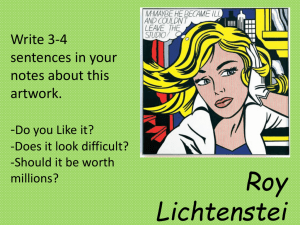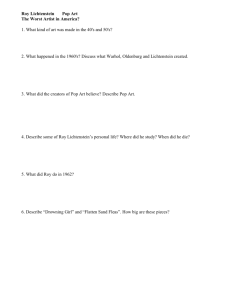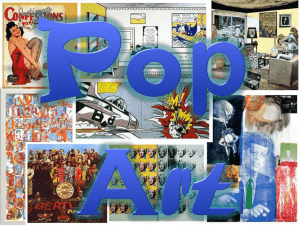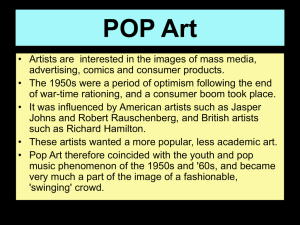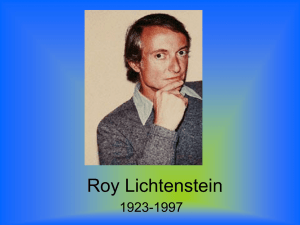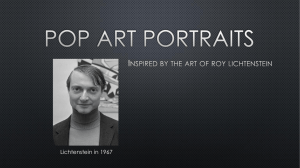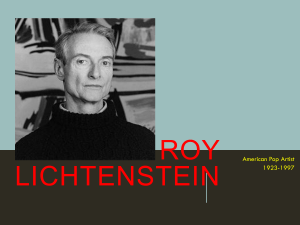Pop art
advertisement
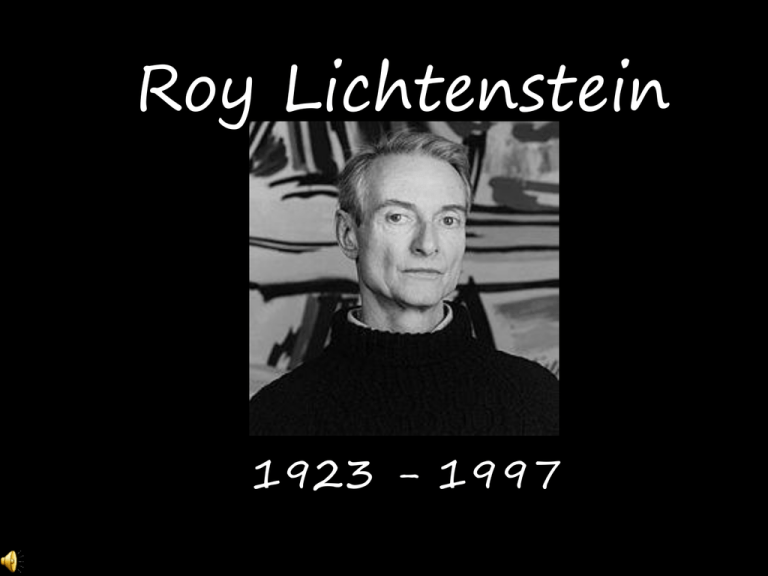
Roy Lichtenstein 1923 - 1997 FACTS: Name: Roy Fox Lichtenstein Born: October 27, 1923, NY Died: September 29, 1997, NY Periods: Modern art, Pop art Children: Mitchell Lichtenstein, David Hoyt Lichtenstein Education: Ohio State University Roy Lichtenstein was a prominent artist of the “Pop Art” movement. This was an art era that used popular culture in its work. Lichtenstein is often grouped with artists such as Andy Warhol, Jasper Johns, and David Hockney. Some critics felt Lichtenstein was one of the “worst artists in America.” (Source: http://www.lichtensteinfoundation.org/lifemagroy.htm) Lichtenstein responded to this claim and others with “The closer my work is to the original, the more threatening and critical the content. However, my work is entirely transformed in that my purpose and perception are entirely different. I think my paintings are critically transformed, but it would be difficult to prove it by any rational line of argument”. Look Mickey, 1961 Original Art Roy Lichtenstein’s art How are these artworks the same? Same subjects, similar layout (design) How are they different? Less details, fewer colors, and a speech bubble added in the Lichtenstein Drowning Girl, 1963 Wham!, 1963 Oh, Jeff...I Love You, Too..., 1964 Woman with Flowered Hat, 1963 On May 15, 2013, this painting sold for $56 million dollars. Sandwich and Soda, 1964 Let’s look again at the work “Oh, Jeff…” If you look very closely at the artwork, you can see the individual dots that make up the picture. This method of dot painting is called Benday dots. You also notice the thick lines and bold colors. It is a representation of the comics when they had a limited color palette. To achieve a Lichtenstein inspired artwork, start with a photograph. Draw the lines of the subject using thick black lines. Add a speech or thought bubble. Leave it white, with black lettering in all capitals. Fill in dots for the color, with only a select few parts of the work colored solid. Pop art: an art style developed in the 1960s that drew visual inspiration from popular visuals such as tabloids, cartoons, ads, packaging, and billboards. Pop artists enlarged their images to comment on the importance of media in American life. Andy Warhol, Claes Oldenburg, and Roy Lichtenstein were three of the most famous Pop artists. benday dots: a dot/grid system used to create tones or shading in screen printing, especially in the commercial art world of the 1960s. Pixels on a computer are a contemporary parallel. Tones can be changed by varying the color, number, and size of the dots per inch. color scheme: a group of colors an artist purposefully chooses to use. Different color combinations can create a variety of moods such as peaceful, active, dynamic or discordant in a work of art. Artists are aware of the interplay of colors in many color schemes. grid: a system that divides a space into evenly sized areas text balloon: the area of a cartoon that contains words. The balloon can be directed to a character’s mouth with an arrow, or be connected via a series of dots of diminishing size to the head as if the subject were thinking the message. contour line: a thick, dark line that outlines important shapes as in a cartoon editing/cropping: removing unnecessary space or shapes from a picture or photo. Artists such as Roy Lichtenstein edited and cropped images to help viewers focus on only the most important features and ideas. context: the usual place or environment where something can be seen. Pop artists took objects out of their usual contexts (cartoons, ads) and turned them into large-scale works of art. Today, you will begin making an art piece inspired by the work of Roy Lichtenstein. Start by getting out your computer and finding a photograph or comic panel that you would like to replicate. Look for something that has a simple design with only one focal subject and not too many intricate details. Print one copy of it in black and white, and one in color. On the black and white print, trace over the lines in black sharpie. This is so that you can see the lines easier in the next step. Set the color copy aside for now. Lay a blank sheet of paper over the copy you just drew on with black sharpie. Add a speech bubble in it as well. Trace over the lines of the print in black sharpie, so that you have an outline of the photograph. Using tempera paints with only 3 or 4 colors (plus black), paint in the solid colored areas first. Refer to your colored print. Be sure not to paint over the black sharpie lines. Use the flat end of a bamboo skewer to paint in the dots of the areas in your painting. Be sure the dots are in a straight line and parallel to each other. In the speech/thought bubble, put a caption in it in all capitals to go with the photograph.
